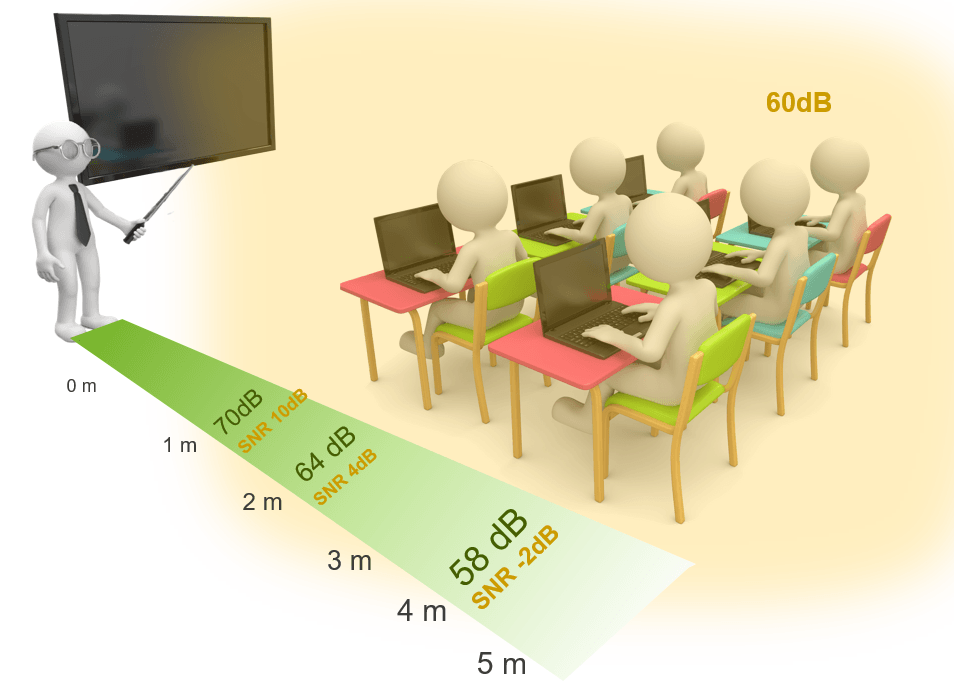
Psst—please be quiet!
Everyday school noise can have a serious impact on the (hearing) health of students and teachers. However, there are solutions to combat acoustic stress in the classroom.
Does this scenario sound familiar from your school days? You’re sitting in the back row and somehow you can hear everything—just not the teacher. There is whispering and discussing of meetings for the afternoon… and suddenly a teacher’s loud voice penetrates to the back of the room, asking for your attention. Oh yes, someone else was in the room! It’s pretty exhausting, being in a lesson like this. Although all you have to do is listen, you often feel “strung out”.
But where do these ambient sounds actually come from, when everyone is only talking quietly? There are actually two fronts converging here—so let’s take a look at them.
For optimal understanding and learning—whether in classrooms or meeting rooms—all listeners should be able to understand the voice of the speaker as clearly as possible. Let’s take the example of a classroom, where students spend 75% of the day on activities related to hearing, listening, and understanding.1
The number of students per class is continually increasing, and the number of students with an immigrant background is increasing disproportionately. Understanding well becomes increasingly important and, at the same time, increasingly difficult in big groups. It is not without reason that schools used to have “language laboratories” for teaching foreign languages using headphones, in order to make everything optimally audible. Unfortunately, these did not catch on.
For teachers, increases in class sizes often mean an increase in vocal effort and mental stress due to the elevated classroom noise level of 60 to 77 dB(A)2. Indeed, it is nice to see that classrooms are increasingly being modernized or, in the case of new buildings, being equipped with complete technical and visual facilities: attractive interior design, good light distribution, Internet, interactive digital boards, etc. However, classroom acoustics are often neglected.
Sound-reflecting surfaces and the distance between speaker and listener lead to two challenges: unwanted delayed echoes (reverberation) and an unfavorable volume ratio of speech (teacher) to noise (classroom noise level).
DIN standard 18041 (2016) recommends that classrooms—depending on the use of the room (language, music lessons) and volume—have a reverberation value of max. approx. 0.5 sec. The reality shows that this is implemented in only very few cases: One in three classrooms do not meet the acoustic requirements;3 in some cases, the reverberation time values are over 2 sec., resulting in poor speech comprehension. In America, similar standards are also suggested by American Speech-Language-Hearing Association (ASHA). ASHA recommends that the SNR should be at least +15dB at the child’s ear and reverberation times should not exceed 0.6-0.7 seconds.4

Sound-absorbing measures such as ceiling absorbers, but also curtains, etc. can help to significantly reduce the reverberation. However, a reduced reverberation still does not change the fact that speech fades away over the length of a classroom which can be up to 10 m.
Let’s assume that the teacher speaks at 70 dB measured at a distance of 1 m. The speech volume is now reduced by 6 dB each time the distance is doubled and the noise (average ambient noise, 60 dB) remains constant. Even at a distance of 4 m the noise is already predominant (SNR = -2 dB). To achieve effective speech comprehension, an advantage of +15 dB is required—ideally wherever you are in the classroom. How can this be achieved? And how can the vocal strain experienced by teachers—which leads to 1 million hours of lessons being lost without replacement every week in Germany5—be reduced?
The Association of German Engineers (Verein Deutscher Ingenieure, VDI 2058) prescribes a background noise level of no more than 55 dB in rooms where cognitive activities are predominantly carried out (as in any quiet office). In this environment, one should be able to “comprehend”. Similarly, ASHA recommends that unoccupied classroom noise levels do not surpass 35dB(A).
In order to achieve these values and good speech comprehension among students, as well as minimal vocal effort from the teacher, so-called Soundfield systems are increasingly being used. Thousands of these systems have already been installed in the US and Canada, as more and more schools discover the benefits. Numerous studies over the past 20 years have shown that the use of Soundfield boosts exam results and student participation while reducing the incidence of behavioral problems in students and voice problems in teachers.
A Soundfield system consists of a wireless transmitter microphone and one or more speakers that evenly distributes the teacher’s voice throughout the room, making it easy to hear. Thanks to cylindrical sound dispersion, even with just one sound column, modern systems are able to distribute the sound across the room with just a 3-dB distance loss, so that the teacher’s voice is distributed almost equally throughout the room.
A regular mono speaker with omnidirectional characteristics does not do that. So, while it might be great for students in the last row, the sound signal in the front row is far too loud. Another point is the transfer characteristic. Good systems only minimally amplify the speech-specific range and adjust adaptively to the ambient noise, so that “acoustic predominance,” i.e. a positive SNR, is always present everywhere in the room, thus providing optimal listening conditions for the learning success of the students.
Studies show that teachers also benefit greatly from a Soundfield system, which ensures 100% less voice fatigue (the absence of teachers due to vocal strain and fatigue reduced from 15% to an average of 2–3% within one year).6-10
Studies by Professor Marion Herrmann-Röttgen, Professor of Health Sciences, Teacher Educator and Speech Trainer, show the benefits of a Soundfield system in a modern teaching structure:11
- no/reduced vocal strain
- speakers do not have to repeat anything
- significantly less background noise
- increased student attention, especially in the last lessons of the day
- significant acceleration in linguistic development of weak students
- improved learning performance of children
If you would like to learn more about acoustics and Soundfield system use in schools, I recommend reading the four studies on the subject of acoustics and learning behavior by Marion Hermann Röttgen and Gero Kerig (2015, ISBN 978-3-95612-102-9).
I also invite you to read our recently published Soundfield Compendium which is a review of classroom soundfield amplification systems. You can find it on the Phonak Evidence page.
1 Dahlquist, L.H. (1998, March). Classroom amplification: Not just for the hearing impaired anymore. Paper presented at the California State University Northridge Center Conference, Los Angeles, CA. / Smaldino, J.J., & Crandell, C.C. (2000). Classroom amplification technology: Theory and practice. Language, Speech and Hearing Services in Schools, 31, 371-375.
2 Dockrell J, Shield B (2004). Children’s perceptions of their acoustic environment at school and at home. J Acoust Soc Am 115: 2964-2973.
3 „Lärmschutz in Hessen“, Hessisches Landesamt für Umwelt und Geologie, Heft 4, 2007
4American Speech-Language-Hearing Association. (2002). Appropriate School Facilities for Students With Speech-Language-Hearing Disorders [Technical Report]. Available from www.asha.org/policy
5 Spiegel Online (2012): Unterrichtsausfall. Gymnasiasten verpassen ein ganzes Schuljahr. www.spiegel.de/lebenundlernen/schule/unterrichtsausfall-gymnasiasten-verpassen-ein-ganzes-schuljahr-a-812028.html
6Das MARRS Projekt: Mainstream Amplification Resource Room Study. 2005. http://www.classroomhearing.org/research/marrsStudy.html (letzter Zugriff: 28.11.2016)
7Kirketerp, M and Larsen, N.B. (2006). Soundfield Enhances Sounds and Learning Environments for Teachers and Students. Danish Soundfield Study.
8Mülder, H. (2011). Phonak FSN: Traditional or Dynamic SoundField
9Roy, N., Weinrich, B., Gray,S.D., Tanner, K., Toledo, S.W., Dove, H., Corbin-Lewis, K., Stemple, J.C. (2002). Voice Amplification Versus Vocal Hygiene Instruction for Teachers With Voice Disorders: A Treatment Outcomes Study. Journal of Speech, Language and Hearing Research, 45, 625-638.
10Sapienza, C.M., Crandell, C.C., Curtis, B. (1999). Effects of Soundfield Frequency Modulation Amplification on Reducing Teacher’s Sound Pressure Level in Classroom. Journal of Voice, 13(3), 375-381
11 Hermann-Röttgen, M., Kerig, G. (2015). Besser hören – besser zuhören – besser lernen: Vier Studien zum Thema Akustik und Lernverhalten. opus magnum.
